
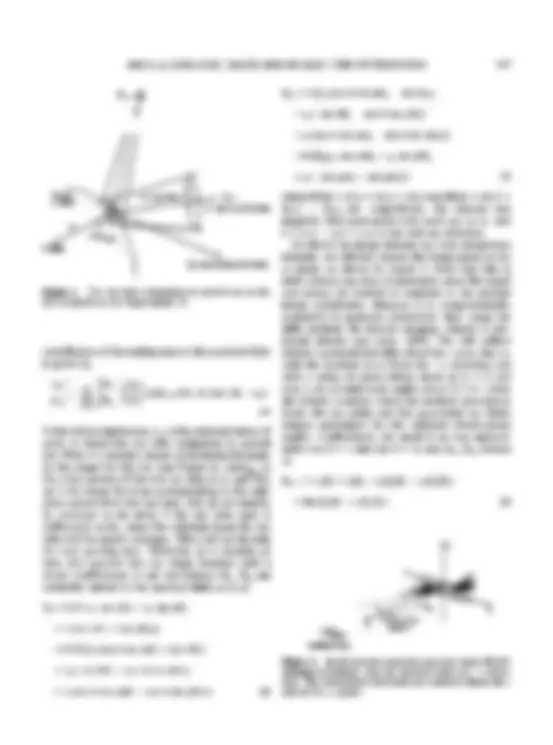
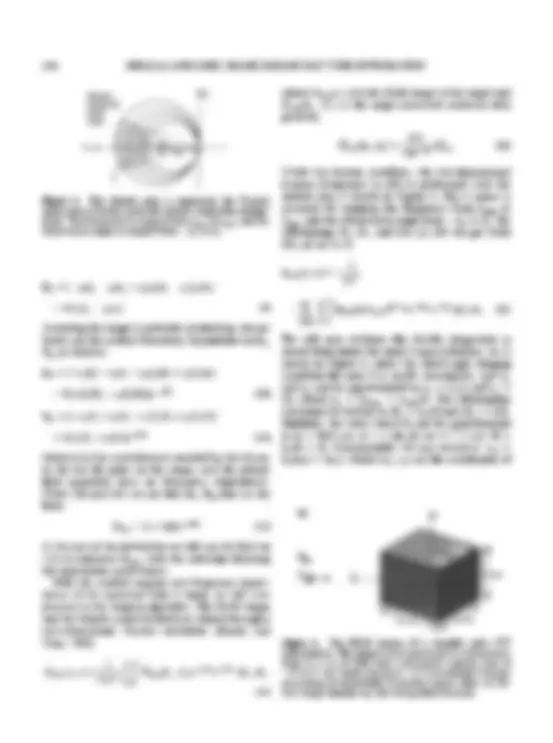
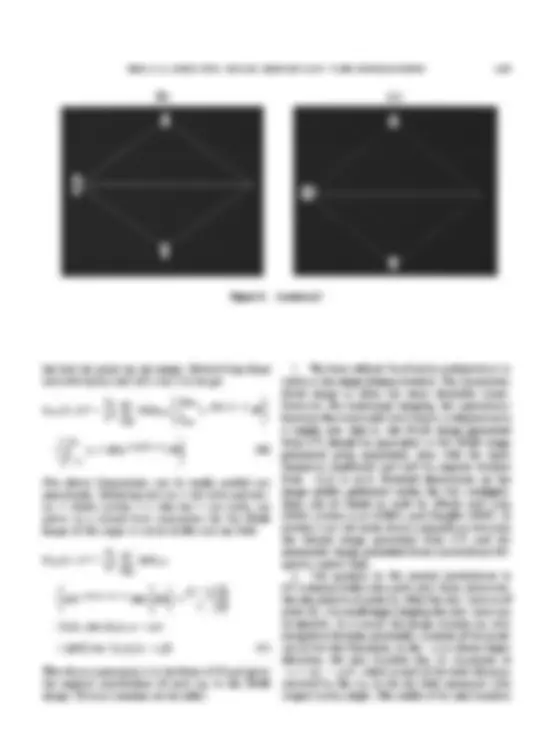
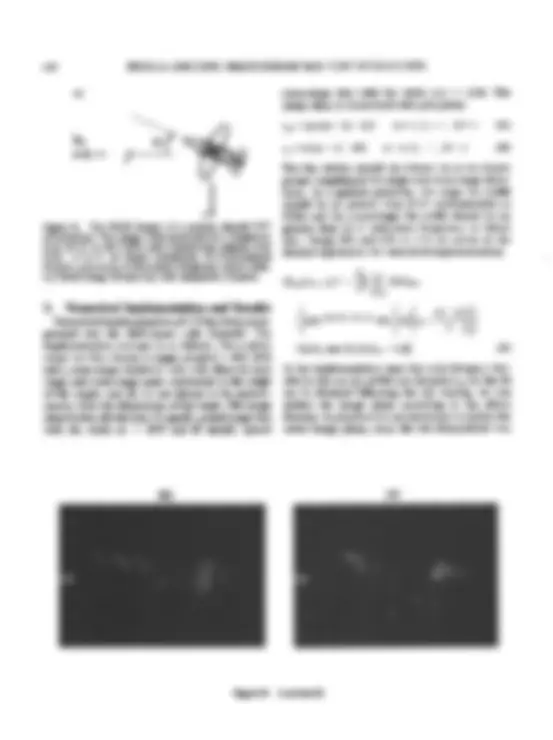
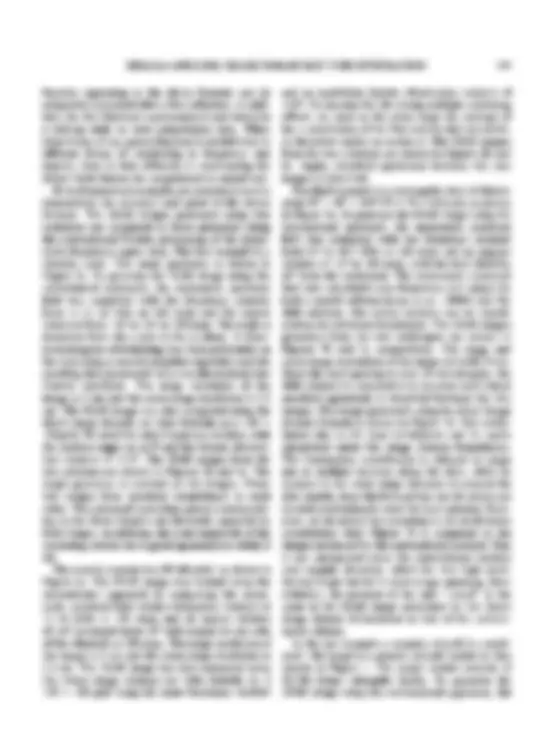
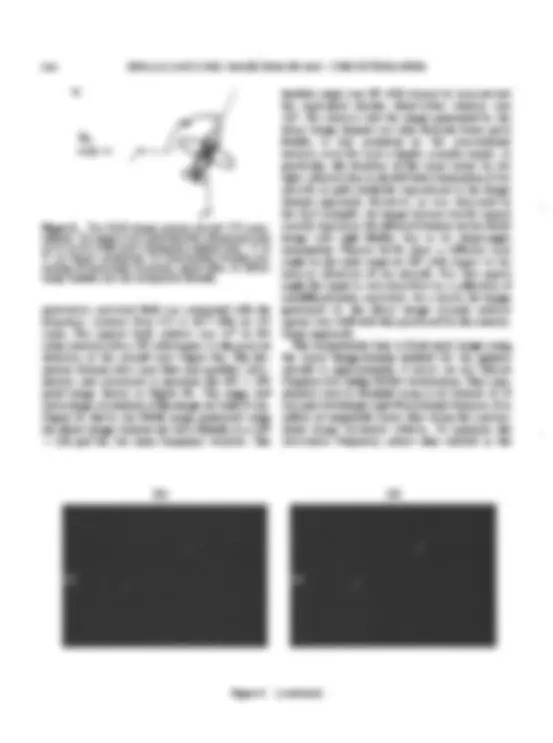


Study with the several resources on Docsity

Earn points by helping other students or get them with a premium plan


Prepare for your exams
Study with the several resources on Docsity

Earn points to download
Earn points by helping other students or get them with a premium plan
Community
Ask the community for help and clear up your study doubts
Discover the best universities in your country according to Docsity users
Free resources
Download our free guides on studying techniques, anxiety management strategies, and thesis advice from Docsity tutors
A simple image domain ray tube integration formula to efficiently compute the inverse synthetic aperture radar (isar) image of a complex target using the shooting and bouncing ray (sbr) technique. The conventional approach for isar image formation involves inverse fourier transforming the computed scattered field data over frequency and aspect, while the proposed image domain formula directly gives the contribution of each ray to the overall isar image. Simulation results using the sbr-based code 'xpatch' demonstrate that the direct image domain method results in good image quality and superior time performance compared to the conventional frequency aspect approach. The paper derives the image domain ray tube integration formula from first-principle electromagnetics and examines the image quality and simulation time of the image domain formulation when applied to both canonical and realistic complex targets.
Typology: Schemes and Mind Maps
1 / 12

This page cannot be seen from the preview
Don't miss anything!







Radio Science, Volume 30, Number 5, Pages 1435-1446, September-October 1995
Department of Electrical and Computer Engineering, University of Texas at Austin, Austin
gets at high frequencies. One such implementation,
Ling [1992] to simulate the radar returns from
complex media. The basic idea behind the SBR
Rays are traced according to the laws of geometri- cal optics as they bounce around the target. At the
point). While the basic idea behind the SBR meth-
Copyright 1995by the American GeophysicalUnion. Paper number 95RS02110. 0048-6604/95/95RS-02110508.
1992; Lee and Andersh, 1993; Andersh et al., 1994], which is currently used by the Air Force and the aerospace industry in programs related to target
simulation results of a direct image formation
nique.
typically achieved by utilizing the monostatic scat-
look angles and frequencies. From a numerical simulation point of view, this is usually a rather time-consuming process. For SBR-based calcula-
operation, since for every new look angle on the target a new set of rays must be launched and traced
have recently utilized bistatic scattered field data to
Since ray tracing is performed once for the incident
for every look angle, the bistatic image formation
1435
(2)
where the quantity in the parentheses is the total scattered field at frequency to and aspect 0 and is obtained through the summation over all exit rays. By interchanging the order of the inverse Fourier transform and the ray summation, the ISAR image can be formed by
i rays
Figure 1. The shootingand bouncingray (SBR) method is a high-frequencysimulationtechniqueused for predict- ing the radar cross section of complex targets. Rays are launched from the incident direction toward the target. The scattered field is computed by summingthe exit ray contributions.
Ling and Bhalla, 1993a]. This formula gives the explicit contribution of each exit ray in the time domain. Therefore by summing the contribution from each ray in the time domain directly, the
obtained without resorting to any multifrequency calculations'
i rays
this work we shall show that the time domain
bistatic imaging scheme of Bhalla and Ling [1993],
of each ray to the overall ISAR image of a target. To illustrate our idea we first note that in the
tered field must be computed over a band of fre- quenciesand angles. Subsequently, by inverse Fou- rier transforming the resulting two-dimensional data, the ISAR image of the target, O(x, z), can be obtained [Farhat et al., 1984; Li and Farhat, 1989].
derive a closed form expression. We should point out that the direct image domain
ulation of Radar Image (SRIM) program [Arnold et al., 1984; LaHaie, 1985; Burns and Herrick, 1992; Herrick, 1992a, b]. However, the aim of this paper is to derive, from first-principle electromagnetics, the image domain ray tube integration formula under the SBR context. Moreover, we shall exam- ine the image quality and simulation time of the image domain formulation when applied to both
in section 2. In section 3 simulation results using the image domain method will be compared against the
ods will also be discussed.
[1988]. The scattered far field from a target in the
can be written as
e -jkr ES(w,0, •b)=- (^) F (bAo+ •A4,) (4)
where k = to/c. When the SBR method is used, the
Bistatic Scattered Field
•kx
Figure 4. The shaded area S represents the Fourier space data collected under the bistatic scattering arrange- ment. The frequency is steppedfrom kmin to kmax,and the observationangle is steppedfrom -190 to 19o-
Assumingthe target is perfectly conducting, we can
B4 asfollows:
Bo = ((-SlE• + s3E] - s2ZoH• + s3ZoH•)
to the last hit point on the target, and the primed
From(10)and(11) we seethatB0, B4 takeon the form
Bo,•,= (a + Ol3)e-jka' (12) In the rest of the derivation we will use the form in (12) to representBo,4,,with the subscriptdenoting the appropriate polarization. With the explicit angular and frequency depen- dence of the scattered field in hand, we will now proceed to the imaging algorithm. The ISAR image and the bistatic scattered field are related through a two-dimensional Fourier transform [Bhalla and Ling, 1993]'
(2,r)2 0o,4,(k,,,kz)e-Jkxxe-j•zzdkxdkz (13)
whereO0,,(x, z) is theISAR imageof thetargetand 0o,4,(k,•,kz) is the range-correctedscatteredfield given by 477'/' Oo,,(k•, kz)=_jke_J•:rEo,• (14)
Under the bistatic condition, the two-dimensional k-space integration in (13) is performed over the shaded area S shown in Figure 4. The k space is
substituting (4), (5), and (14) in (13) we get (with S(0,. qb)set to 1)
'Zi rays fsfBo,•(AA)exite3•'rAe
(15)
We will next evaluate the double integration in closed form under the small 0 approximation. As is shown in Figure 3, under the small-angle imaging
Similarly, the wave vector k can be approximated
(a)
Einc
Ill
z
y
in
Figure 5. The ISAR images of a rhombic cube (VV polarization). The imageswere generated for a frequency scan of 11 to 16 GHz and a monostatic angular scan of -6 ø to 6ø. (a) Target geometry. (b) Conventional Fourier processingof monostatic frequency-aspect data. (c) Di- rect image domain ray tube integration formula.
(b) (c)
Figure 5. (continued)
the last hit point on the target. Substituting these approximations and (12) into (15) we get
O•,• (x, z) = (^) •2. (Z•[)exit e dk I S min
(16)
The above integrations can be easily carried out analytically. Denoting sinc (u) = sin (u)/u and sinc' (u) = d(sinc (u))/du = (-sinc (u) + cos (u))/u, we arrive at a closed form expression for the TSAR image of the target in terms of the exit ray field:
ko
i rays
.{Ake_Jt•o(2z+cli_zi)sinc[Ak(z+^ di 2 -z/)]}
ß{2aOo sinc [koOo(x- xi)] 2
The above expression is in the form of (3) and gives the explicit contribution of each ray to the TSAR image. Several remarks are in order:
image quality generated under the two configura- tions can be found in work by Bhalla and Ling [1993], Farhat et al. [1984], and Shaeffer [1992]. In section 3 we will make direct comparisons between the bistatic image generated from (17) and the monostatic image generated from conventional fre- quency aspect data.
order 003. Forsmall-angleimagingthesinc'termcan be ignored. As a result, the image domain ray tube integration formula essentially consistsof the prod- uct of two sinc functions. In the -z (or down range) direction, the sinc function has its maximum at
traveled by the ray to the far field measured with respect to the origin. The width of the sinc function
x
(a) Targetgeometry
45 ø! "x •0" square cross-section
(c) (d)
I ..l• ii i• : .... .•. •I ii
Figure 7. The ISAR imagesof a rectangularduct (HH polarization). The imageswere generatedfor a frequency scan of 9.5 to 10.5 GHz and a monostatic angular scan from -3 ø to 3ø. (a) Target geometry. (b) Conventional Fourier processingof monostaticfrequency aspect data generated using a modal technique. (c) Conventional Fourier processingof the monostatic frequency aspect data generated using the shooting and bouncing ray technique. (d) Direct image domain ray tube integration formula.
cross-range coordinate [Walker, 1980; Mensa, 1981], and this results in the above conclusion.
explicitly stated, a comment is in order on the
narios. It is well known that the cross-range reso-
frequency. For example, at 10 GHz the angular window needed to achieve a 15-cm cross-range resolution is 6ø. At 2 GHz the needed angular window for the same resolution widens 30 ø. There-
suited for high-frequency imagery at X band and above. At lower frequencies the wider angular
(a)
Ei•c
Figure 8. The ISAR imagesof a genericaircraft (VV polarization).The imageswere generatedfor a frequency scan of 9.5 to 10.5 GHz and a monostatic angular scan from -3 ø to 3ø. (a) Target orientation. (b) Conventional Fourier processingof monostaticfrequencyaspectdata. (c) Direct image domain ray tube integrationformula.
with bin width A r = R/N and M equally spaced
Xm = Acr(rn - 1) - L/2 rn = 1, 2, ... , M + 1 (18)
Zn = Ar(n - 1) - R/2 n = 1, 2, ..., N q- 1 (19)
The bin widths should be chosen so as to ensure
(0o). Using (18) and (19) in (17) we arrive at the
ko O0,•b(Xm,Zn)'-qr2i raysE (•)exit
ß{2a0o sinc [koOo(xm- xi)]} (20)
Figure 8. (continued)
(a)
E•c
/
120 ø
Figure 9. The ISAR images generic aircraft (VV polar- ization). The images were generated for a frequency scan of 9.5 to 10.5 GHz and a monostatic angular scan -3 ø to 3ø. (a) Target orientation. (b) Conventional Fourier pro- cessing of monostatic frequency aspect data. (c) Direct image domain ray tube integration formula.
steps. The angular look window was _+3ø in 124 stepscentered about 30øwith respect to the nose-on direction of the aircraft (see Figure 8a). The fre-
matted, and processed to generate the 256 x 256 pixel image shown in Figure 8b. The range and cross-rangeresolutions of the image are both 15 cm. Figure 8c shows the ISAR image generated using the direct image domain ray tube formula on a 256 x 256 grid for the same frequency window. The
incident angle was 30ø with respect to nose-on and
_+6ø. We observe that the image generated by the direct image domain ray tube formula bears good fidelity to that produced by the conventional method, even for such a highly complex target. In
fight, which is due to the left inlet termination of the
domain approach. However, as was discussed in
exactly reproduce the diffused features in the ISAR
assumption. Figures 9a-9c show a different look
angle the target is well described by a collection of nondiffusedpoint scatterers. As a result, the image generated by the direct image domain method agrees very well with that produced by the conven- tional approach.
the direct image-domain method for the genetic aircraft is approximately 4 hours on our Silicon
orders of magnitude faster than using the conven- tional image formation scheme. To generate the monostatic frequency aspect data needed in the
(c)
Figure 9. (continued)
conventional scheme, we estimate that it would
oppose to the entire 256 x 256 grid. This is in contrast to the conventional data collection in the
approachfor both canonical as well as realistic com-
require calculation of monostatic scattered field at
ray spread function needs to be taken into account.
conductingtargets. When these conditions are met, the tremendous time advantage makes this scheme
tion.
Acknowledgments. The authors are grateful to S. W. Lee for providingthe variousversionsof Xpatch and for many helpful discussions.The authors would also like to thank D. J. Andershfor providingthe monostaticXpatch simulation data and for his continued support of this work. This work was supportedby NASA grant NCC3- 273 and in part by the Joint ServicesElectronicsProgram under contract AFOSR F49620-92-C-0027.
References
Andersh, D. J., M. Hazlett, S. W. Lee, D. D. Reeves, D. P. Sullivan, and Y. Chu, Xpatch: A high frequency electromagnetic-scatteringprediction code and envi- ronment for complex three-dimensionalobjects, IEEE Antennas Propagat Mag., 6, 65-69, 1994. Arnold, C. L., K. A. Augustyn, G. D. Darling, and I. J. LaHaie, Simulated SAR imagesfrom three-dimensional computer-modeledscenes, paper presented at 30th Tri-Services Radar Symposium, Monterey, Calif., June 26-28, 1984. Baldauf, J., S. W. Lee, L. Lin, S. K. Jeng, S. M. Scarborough,and C. L. Yu, High frequency scattering from trihedral corner reflectors and other benchmark targets:SBR versusexperiment, IEEE Trans. Antennas Propagat., 39, 1345-1351, 1991. Bhalla, R., and H. Ling, ISAR image formation using bistatic computed from shooting and bouncing ray technique, J. E!ectromagn. Waves App!., 7(9), 1271- 1287, 1993. Bhalla, R., and H. Ling, A fast algorithm for signature prediction and image formation using the shootingand bouncing ray technique, IEEE Trans. Antennas Propag., in press, 1995. Burns, J. W., and D. F. Herrick, Advancements in modeling and simulation of radar signatures, Tech. Rep., Environ. Res. Inst. of Mich., Ann Arbor, 1992. Farhat, N.H., C. L. Werner, and T. H. Chu, Prospectsof three-dimensionalprojective and tomographicimaging